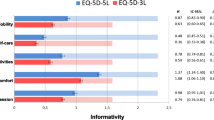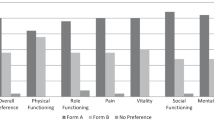Abstract
The purpose of this paper is to discuss the results of a direct comparison of two instruments, the SF-12 health survey and the EuroQol Group's EQ-5D, in a sample drawn from the adult US population. The data were collected via a survey instrument mailed to 1,800 subjects in the USA. The instrument contained the EQ-5D valuation questionnaire and the items of the SF-12. In addition, the subjects were asked to provide demographic information, complete a depression screening item and to indicate if they had any of seven common chronic conditions. The usable response rate was 23.7%. Patients indicating a health problem on the EQ-5D had significantly lower mean SF-12 component scores (i.e. MCS-12 and PCS-12) for all dimensions. As was expected, the relationships were stronger between the EQ-5D functional dimensions and the PCS-12 and between the MCS-12 and the EQ-5D anxiety/depression dimension. The EQ-5D visual analogue scale (VAS) scores were positively correlated with both component scores; r=0.55 for PCS-12 and r=0.41 for MCS-12. The results of this investigation provide support for the validity of both the EQ-5D and the SF-12 as descriptive measures of health status. The measurements by both instruments behaved in patterns that were consistent with recognized sociodemographic differences in health status. The limitations of the dimensional structure of the EQ-5D were somewhat overcome by the use of the VAS, which may also be possible with a constructed index score based on explicit values derived from a general population. The SF-12 appeared to be more sensitive to differences associated with less severe morbidity.
Similar content being viewed by others
References
Kind P. The EuroQoL instrument: an index of health-related quality of life. In: Spilker B, ed. Quality of Life and Pharmacoeconomics in Clinical Trials, 2nd edn. Philadelphia, PA: Lippincott-Raven Publishers, 1996: 191-201.
EuroQol Group. EuroQol — a new facility for the measurement of health-related quality of life. Health Policy 1990; 16: 199-208.
Ware JE Jr, Sherbourne CD. The MOS 36-item Short-Form Health Survey (SF-36). I. Conceptual framework and item selection. Med Care 1992; 30: 473-483.
Ware JE, Kosinski M, Keller SD. A 12-item Short-Form Health Survey: construction of scales and preliminary test of reliability and validity. Med Care 1996; 34: 220-226.
Revicki DA, Kaplan RM. Relationship between psychometric and utility-based approaches to the measurement of health-related quality of life. Qual Life Res 1993; 2: 477-487.
Brazier J, Jones N, Kind P. Testing the validity of the Euroqol and comparing it with the SF-36 health survey questionnaire. Qual Life Res 1993; 2: 169-180.
Johnson JA, Coons, SJ, Ergo A, Szava-Kovats G. Valuation of the EuroQol (EQ-5D) health states in an adult US-based sample. PharmacoEconomics 1998; in press.
Paolillo JGP, Loremzi P. Monetary incentives and mail questionnaire response rates. J Advertising 1984; 13: 46-48.
Blythe BJ. Increasing mailed survey responses with a lottery. Soc Work Res Abstracts 1986; 12: 18-19.
Ettl M, Hays RD, Cunningham W, Shapiro MF. Assessing health-related quality of life in disadvantaged populations. In Spilker B, ed. Quality of Life and Pharmacoeconomics in Clinical Trials, 2nd edn. Philadelphia, PA: Lippincott-Raven Publishers, 1996: 595-604.
Ware JE, Kosinski M, Keller SD. SF-12: How to Score the SF-12 Physical and Mental Health Summary Scales. Boston, MA: The Health Institute, New England Medical Center, 1995.
Kind P. Measuring Valuations for Health States: a Survey of Patients in General Practice. York: Centre for Health Economics, University of York, 1990. Discussion Paper #76.
Brooks RG, Jendteg S, Lindgren B, Persson U, Bjork S. EuroQoL: health-related quality of life measurement. Results of the Swedish questionnaire exercise. Health Policy 1991; 18: 25-36.
Nord E. EuroQoL: health-related quality of life measurement. Valuations of health states by the general public in Norway. Health Policy 1991; 18: 37-46.
Kind P, Gudex C, Dolan P, Williams A. Practical and methodological issues in the development of the EuroQol: the York experience. Adv Med Sociol 1994; 5: 219-253.
Author information
Authors and Affiliations
Rights and permissions
About this article
Cite this article
Johnson, J.A., Coons, S.J. Comparison of the EQ-5D and SF-12 in an adult US sample. Qual Life Res 7, 155–166 (1998). https://doi.org/10.1023/A:1008809610703
Issue Date:
DOI: https://doi.org/10.1023/A:1008809610703




